

Compact Muon Solenoid
LHC, CERN
| CMS-SUS-16-032 ; CERN-EP-2017-144 | ||
| Search for the pair production of third-generation squarks with two-body decays to a bottom or charm quark and a neutralino in proton-proton collisions at $ \sqrt{s} = $ 13 TeV | ||
| CMS Collaboration | ||
| 23 July 2017 | ||
| Phys. Lett. B 778 (2018) 263 | ||
| Abstract: Results are presented from a search for the pair production of third-generation squarks in proton-proton collision events with two-body decays to bottom or charm quarks and a neutralino, which produces a significant imbalance in the transverse momentum. The search is performed using a sample of proton-proton collision data at $ \sqrt{s} = $ 13 TeV recorded by the CMS experiment at the LHC, corresponding to an integrated luminosity of 35.9 fb$^{-1}$. No statistically significant excess of events is observed beyond the expected contribution from standard model processes. Exclusion limits are set in the context of simplified models of bottom or top squark pair production. Models with bottom squark masses up to 1220 GeV are excluded at 95% confidence level for light neutralinos, and models with top squark masses of 510 GeV are excluded assuming that the mass splitting between the top squark and the neutralino is small. | ||
| Links: e-print arXiv:1707.07274 [hep-ex] (PDF) ; CDS record ; inSPIRE record ; CADI line (restricted) ; | ||
| Figures & Tables | Summary | Additional Figures & Tables | References | CMS Publications |
|---|
|
Additional information on efficiencies needed for reinterpretation of these results are available here.
Additional technical material for CMS speakers can be found here. |
| Figures | |

png pdf |
Figure 1:
Diagrams showing the pair production of bottom or top squarks followed by their decays according to $\tilde{ \mathrm{ b } } \rightarrow \mathrm{ b } \tilde{ \chi }^0 _1$ (left ) and $\tilde{ \mathrm{ t } } \rightarrow \mathrm{c} \tilde{ \chi }^0 _1$ (right ). |

png pdf |
Figure 1-a:
Diagram showing the pair production of bottom squarks followed by their decays according to $\tilde{ \mathrm{ b } } \rightarrow \mathrm{ b } \tilde{ \chi }^0 _1$. |
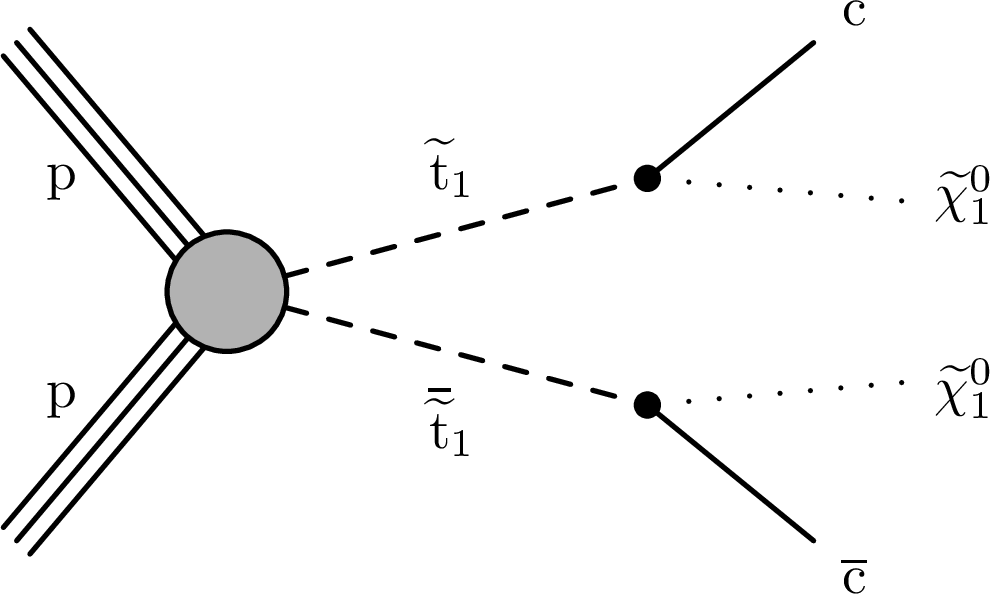
png pdf |
Figure 1-b:
Diagrams showing the pair production of top squarks followed by their decays according to $\tilde{ \mathrm{ t } } \rightarrow \mathrm{c} \tilde{ \chi }^0 _1$. |

png pdf |
Figure 2:
Distribution of ${M_{\mathrm {CT}}}$ (left ) and $ {p_{\mathrm {T}}} (\text {j}_{1})+ {p_{\mathrm {T}}} (\text {j}_{2})$ (right ) for the searches in noncompressed regions from simulation. The stacked, filled histograms represent different background components while the lines show two signal models with different bottom squark and neutralino mass hypotheses, ($m_{\tilde{ \mathrm{ b } } } = $ 900 GeV and $m_{\tilde{ \chi }^0 _1} = $ 300 GeV) and ($m_{\tilde{ \mathrm{ b } } } = $ 1200 GeV and $m_{\tilde{ \chi }^0 _1} = $ 100 GeV). |
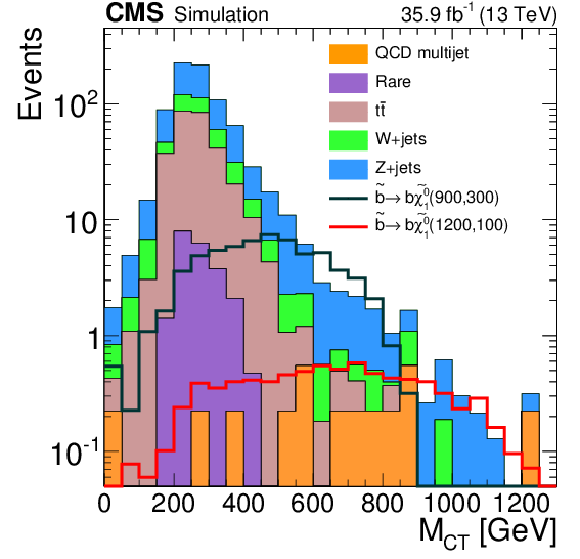
png pdf |
Figure 2-a:
Distribution of ${M_{\mathrm {CT}}}$ for the searches in noncompressed regions from simulation. The stacked, filled histograms represent different background components while the lines show two signal models with different bottom squark and neutralino mass hypotheses, ($m_{\tilde{ \mathrm{ b } } } = $ 900 GeV and $m_{\tilde{ \chi }^0 _1} = $ 300 GeV) and ($m_{\tilde{ \mathrm{ b } } } = $ 1200 GeV and $m_{\tilde{ \chi }^0 _1} = $ 100 GeV). |
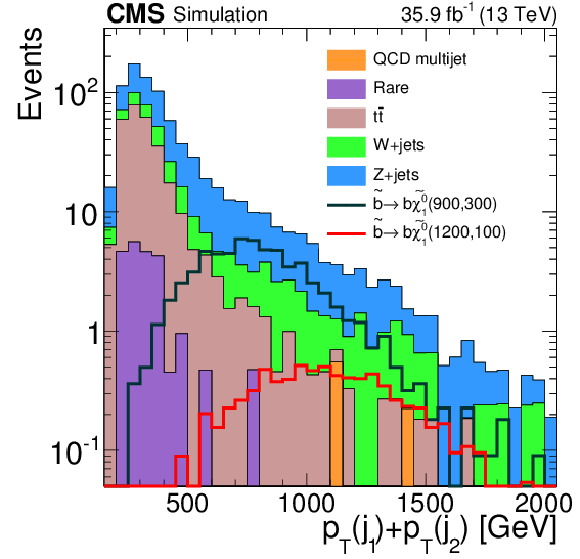
png pdf |
Figure 2-b:
Distribution of $ {p_{\mathrm {T}}} (\text {j}_{1})+ {p_{\mathrm {T}}} (\text {j}_{2})$ for the searches in noncompressed regions from simulation. The stacked, filled histograms represent different background components while the lines show two signal models with different bottom squark and neutralino mass hypotheses, ($m_{\tilde{ \mathrm{ b } } } = $ 900 GeV and $m_{\tilde{ \chi }^0 _1} = $ 300 GeV) and ($m_{\tilde{ \mathrm{ b } } } = $ 1200 GeV and $m_{\tilde{ \chi }^0 _1} = $ 100 GeV). |

png pdf |
Figure 3:
Distributions of the combined b-, c-tagged jet, and SV multiplicity (left ), and ${p_{\mathrm {T}}^{\mathrm {miss}}}$ for events with at least one b- or c-tagged jet (right ), after the baseline selection for the compressed mass spectrum analysis, as obtained from simulation. The stacked, filled histograms represent different background components while the lines show two signal models with different bottom and top squark and neutralino mass hypotheses, ($m_{\tilde{ \mathrm{ b } } } = $ 550 GeV and $m_{\tilde{ \chi }^0 _1} = $ 500 GeV) and ($m_{\tilde{ \mathrm{ t } } } = $ 400 GeV and $m_{\tilde{ \chi }^0 _1} = $ 370 GeV). |

png pdf |
Figure 3-a:
Distribution of the combined b-, c-tagged jet, and SV multiplicity, after the baseline selection for the compressed mass spectrum analysis, as obtained from simulation. The stacked, filled histograms represent different background components while the lines show two signal models with different bottom and top squark and neutralino mass hypotheses, ($m_{\tilde{ \mathrm{ b } } } = $ 550 GeV and $m_{\tilde{ \chi }^0 _1} = $ 500 GeV) and ($m_{\tilde{ \mathrm{ t } } } = $ 400 GeV and $m_{\tilde{ \chi }^0 _1} = $ 370 GeV). |

png pdf |
Figure 3-b:
Distribution of ${p_{\mathrm {T}}^{\mathrm {miss}}}$ for events with at least one b- or c-tagged jet, after the baseline selection for the compressed mass spectrum analysis, as obtained from simulation. The stacked, filled histograms represent different background components while the lines show two signal models with different bottom and top squark and neutralino mass hypotheses, ($m_{\tilde{ \mathrm{ b } } } = $ 550 GeV and $m_{\tilde{ \chi }^0 _1} = $ 500 GeV) and ($m_{\tilde{ \mathrm{ t } } } = $ 400 GeV and $m_{\tilde{ \chi }^0 _1} = $ 370 GeV). |

png pdf |
Figure 4:
Yields in the signal regions targeting the noncompressed (top left) and compressed (top right: $ {N_{\text {b-tags}}} = $ 1, 2, bottom left: $ {N_{\text {c-tags}}} = $ 1, 2, bottom right: $ {N_{\text {b-tags}}} + {N_{\text {c-tags}}} = $ 0) scenarios. Data are shown as black points. The background predictions are represented by the stacked, filled histograms. The expected yields for several signal models are also shown. The lower panels show the ratio of data over total background prediction in each signal region. The hatching indicates the total uncertainty in the background predictions. |

png pdf |
Figure 4-a:
Yields in the signal regions targeting the noncompressed scenario. Data are shown as black points. The background predictions are represented by the stacked, filled histograms. The expected yields for several signal models are also shown. The lower panel shows the ratio of data over total background prediction in each signal region. The hatching indicates the total uncertainty in the background predictions. |
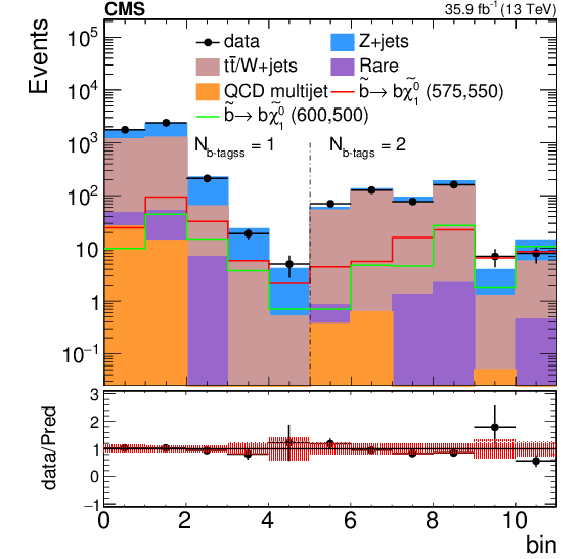
png pdf |
Figure 4-b:
Yields in the signal regions targeting the compressed $ {N_{\text {b-tags}}} = $ 1, 2 scenario. Data are shown as black points. The background predictions are represented by the stacked, filled histograms. The expected yields for several signal models are also shown. The lower panel shows the ratio of data over total background prediction in each signal region. The hatching indicates the total uncertainty in the background predictions. |
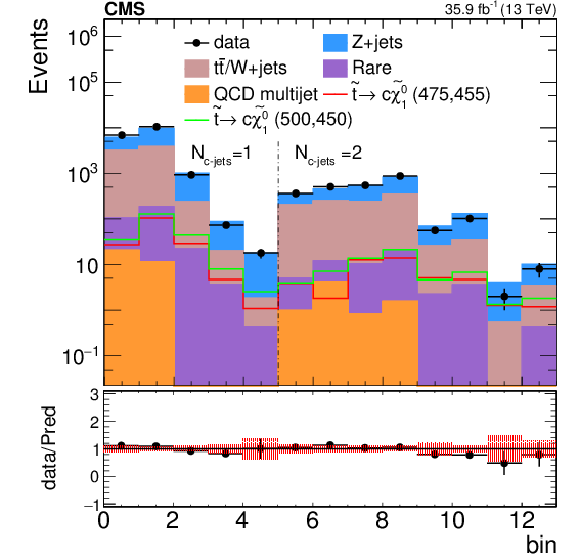
png pdf |
Figure 4-c:
Yields in the signal regions targeting the compressed $ {N_{\text {c-tags}}} = $ 1, 2 scenario. Data are shown as black points. The background predictions are represented by the stacked, filled histograms. The expected yields for several signal models are also shown. The lower panel shows the ratio of data over total background prediction in each signal region. The hatching indicates the total uncertainty in the background predictions. |

png pdf |
Figure 4-d:
Yields in the signal regions targeting the compressed $ {N_{\text {b-tags}}} + {N_{\text {c-tags}}} = $ 0 scenario. Data are shown as black points. The background predictions are represented by the stacked, filled histograms. The expected yields for several signal models are also shown. The lower panel shows the ratio of data over total background prediction in each signal region. The hatching indicates the total uncertainty in the background predictions. |

png pdf root |
Figure 5:
Exclusion limits at 95% CL for direct bottom squark pair production for the decay mode $ {\tilde{ \mathrm{ b } } _{1}} \to \mathrm{ b } \tilde{\chi}^0_1 $. The regions enclosed by the black curves represent the observed exclusion and the ${\pm }1$ standard deviation for the NLO+NLL cross section calculations and their uncertaintes [68]. The dashed red lines indicate the expected limits at 95% CL and their ${\pm }1$ standard deviation experimental uncertainties. |

png pdf root |
Figure 6:
The combined 95% CL exclusion limits for top squark pair production assuming 100% branching fraction to the decay $\tilde{ \mathrm{ t } } \rightarrow \mathrm{c} \tilde{ \chi }^0 _1$. Notations are as in Fig 5. |
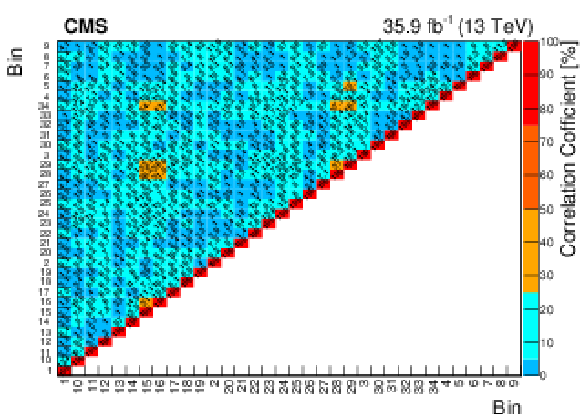
png pdf |
Figure A1:
The correlation matrix for the estimated backgrounds in the noncompressed search region. The bin numbers are defined in Table 5. |

png pdf |
Figure A2:
The correlation matrix for the estimated backgrounds in the compressed search region. The bin numbers are defined in Table A1. |
| Tables | |

png pdf |
Table 1:
A summary of the baseline selections used for the noncompressed and compressed search regions. |

png pdf |
Table 2:
The categorization of ${H_{\mathrm {T}}}$ and ${M_{\mathrm {CT}}}$ for search regions in noncompressed signal models. |
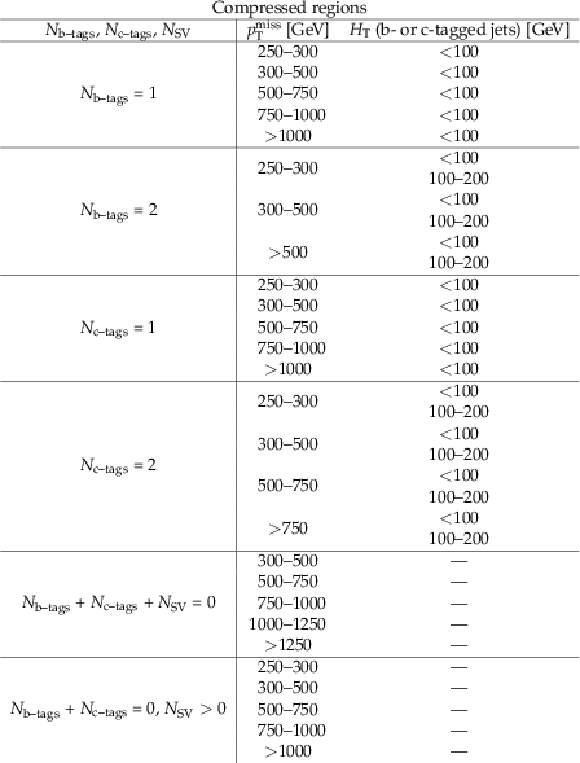
png pdf |
Table 3:
The categorization in ${N_{\text {b-tags}}} $, ${N_{\text {c-tags}}} $, ${N_{\text {SV}}} $, ${H_{\mathrm {T}}} $, and ${p_{\mathrm {T}}^{\mathrm {miss}}}$ for search regions in models with compressed spectra. |

png pdf |
Table 4:
Different systematic uncertainties in the lost-lepton background estimate. |
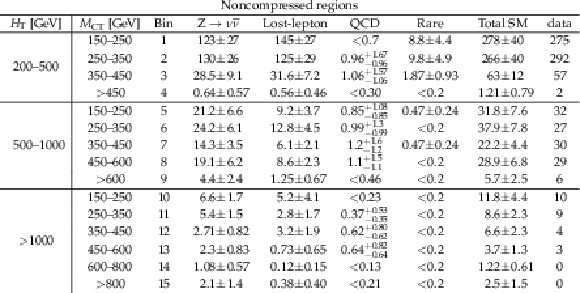
png pdf |
Table 5:
Observed number of events and background prediction in the noncompressed regions. The total uncertainties in the background predictions are shown. |
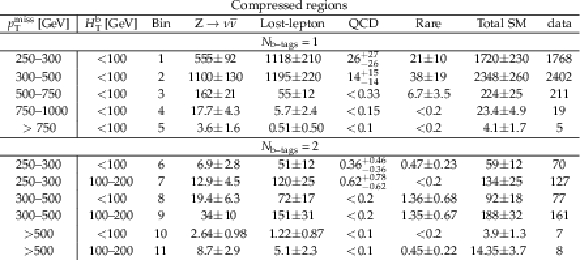
png pdf |
Table 6:
Observed number of events and the background prediction in the compressed regions with $ {N_{\text {b-tags}}} = $ 1, 2. The total uncertainties in the background predictions are also shown. |
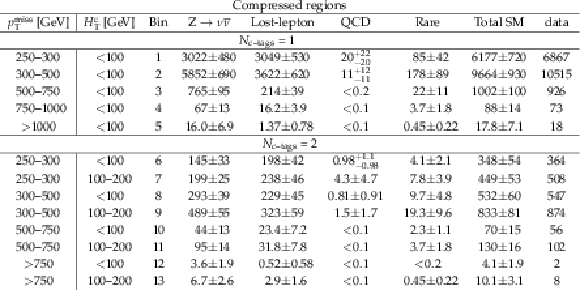
png pdf |
Table 7:
Observed number of events and the background prediction in the compressed regions with $ {N_{\text {c-tags}}} = $ 1, 2. The total uncertainties in the background predictions are also shown. |
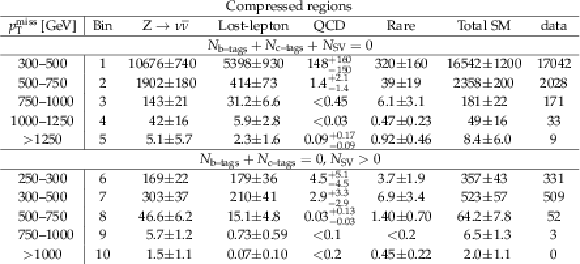
png pdf |
Table 8:
Observed number of events and the background prediction in the compressed regions with $ {N_{\text {b-tags}}} + {N_{\text {c-tags}}} = $ 0. The total uncertainties in the background predictions are also shown. |

png pdf |
Table A1:
The bin number and definition for the compressed search region as shown in Fig. A1. |
| Summary |
| A search for the pair production of third-generation squarks is performed using data collected by the CMS experiment, focusing on two-body decays to bottom or charm quarks. For bottom-squark pair production, the decay mode considered is ${\tilde{ \mathrm{ b } }_{1}} \rightarrow\mathrm{ b }\tilde{\chi}^0_1$, while for top-squark pair production, the decay mode considered is ${\tilde{ \mathrm{ t } }_{1}} \rightarrow\mathrm{c}\tilde{\chi}^0_1$, a flavor-changing neutral current process. No statistically significant excess of events is observed above the expected standard model background, and exclusion limits are set at 95% confidence level in the context of simplified models of direct top and bottom squark pair production. Bottom squark masses below 1220 GeV are excluded assuming that the lightest supersymmetric particle (LSP) is massless; bottom squark masses below 625 GeV are excluded for LSP masses up to 600 GeV. Top squark masses below 510 GeV are excluded for the scenario in which ${\tilde{ \mathrm{ t } }_{1}} \rightarrow\mathrm{c}\tilde{\chi}^0_1$ and the mass splitting between the top squark and the LSP is small. |
| Additional Figures | |

png pdf |
Additional Figure 1:
Observed significances for simplified models of bottom squark pair production in the $\tilde{ \mathrm{ b } } \rightarrow \mathrm{ b } \tilde{ \chi }^0 _1$ decay scenario. |

png pdf |
Additional Figure 2:
Observed significances for simplified models of top squark pair production in the $\tilde{ \mathrm{ t } } \rightarrow \mathrm{c} \tilde{ \chi }^0 _1$ decay scenario. |

png pdf root |
Additional Figure 3:
The covariance matrix for the estimated backgrounds in the noncompressed search region. |
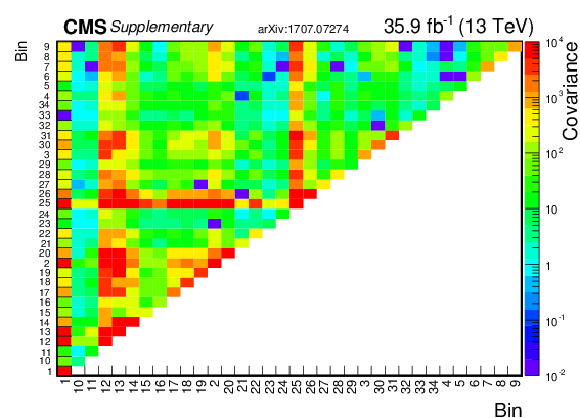
png pdf root |
Additional Figure 4:
The covariance matrix for the estimated backgrounds in the compressed search region. |
| Additional Tables | |

png pdf |
Additional Table 1:
Event yields from simulation for two signal points ($m_{\tilde{ \mathrm{ b } } } = $ 900 GeV and $m_{\tilde{ \chi }^0 _1} = $ 300 GeV) and ($m_{\tilde{ \mathrm{ b } } } = $ 1200 GeV and $m_{\tilde{ \chi }^0 _1} = $ 100 GeV) after applying each requirement in the non-compressed search region. The numbers are normalized to an integrated luminosity of 35.9 fb$^{-1}$ and the uncertainties correspond to statistical uncertainty from the MC samples. |

png pdf |
Additional Table 2:
Event yields from simulation for two signal points ($m_{\tilde{ \mathrm{ b } } } = $ 550 GeV and $m_{\tilde{ \chi }^0 _1} = $ 500 GeV) and ($m_{\tilde{ \mathrm{ t } } } = $ 400 GeV and $m_{\tilde{ \chi }^0 _1} = $ 370 GeV) after applying each requirement in the compressed search region. The numbers are normalized to an integrated luminosity of 35.9 fb$^{-1}$ and the uncertainties correspond to statistical uncertainty from the MC samples. |
| References | ||||
| 1 | R. Barbieri and G. F. Giudice | Upper bounds on supersymmetric particle masses | NPB 306 (1988) 63 | |
| 2 | P. Ramond | Dual Theory for Free Fermions | PRD 3 (1971) 2415 | |
| 3 | \relax Yu. A. Gol'fand and E. P. Likhtman | Extension of the algebra of Poincare group generators and violation of P invariance | JEPTL 13 (1971)323 | |
| 4 | A. Neveu and J. H. Schwarz | Factorizable dual model of pions | NPB 31 (1971) 86 | |
| 5 | D. V. Volkov and V. P. Akulov | Possible universal neutrino interaction | JEPTL 16 (1972) 438.[Pisma Zh. Eksp. Teor. Fiz.16,621(1972)] | |
| 6 | J. Wess and B. Zumino | A lagrangian model invariant under supergauge transformations | PLB 49 (1974) 52 | |
| 7 | J. Wess and B. Zumino | Supergauge transformations in four dimensions | NPB 70 (1974) 39 | |
| 8 | P. Fayet | Supergauge invariant extension of the Higgs mechanism and a model for the electron and its neutrino | NPB 90 (1975) 104 | |
| 9 | H. P. Nilles | Supersymmetry, supergravity and particle physics | PR 110 (1984) 1 | |
| 10 | M. Papucci, J. T. Ruderman, and A. Weiler | Natural SUSY endures | JHEP 09 (2012) 035 | 1110.6926 |
| 11 | G. R. Farrar and P. Fayet | Phenomenology of the production, decay, and detection of new hadronic states associated with supersymmetry | PLB 76 (1978) 575 | |
| 12 | G. Jungman, M. Kamionkowski, and K. Griest | Supersymmetric dark matter | PR 267 (1996) 195 | hep-ph/9506380 |
| 13 | E. Lyndon and B. Philip | LHC Machine | JINST 3 (2008) S08001 | |
| 14 | J. Alwall, P. C. Schuster, and N. Toro | Simplified models for a first characterization of new physics at the LHC | PRD 79 (2009) | 0810.3921 |
| 15 | J. Alwall, M.-P. Le, M. Lisanti, and J. G. Wacker | Model-independent jets plus missing energy searches | PRD 79 (2009) | 0809.3264 |
| 16 | LHC New Physics Working Group, D. Alves et al. | Simplified models for LHC new physics searches | JPG 39 (2012) 105005 | 1105.2838 |
| 17 | CMS Collaboration | Searches for pair production of third-generation squarks in $ \sqrt{s} = $ 13 TeV pp collisions | EPJC 77 (2017) 327 | CMS-SUS-16-008 1612.03877 |
| 18 | ATLAS Collaboration | Search for a supersymmetric partner to the top quark in final states with jets and missing transverse momentum at $ \sqrt{s} = $ 7 TeV with the ATLAS detector | PRL 109 (2012) 211802 | 1208.1447 |
| 19 | ATLAS Collaboration | Search for direct top squark pair production in final states with one isolated lepton, jets, and missing transverse momentum in $ \sqrt{s} = $ 7 TeV pp collisions using 4.7$ fb$^{-1} of ATLAS data | PRL 109 (2012) 211803 | 1208.2590 |
| 20 | ATLAS Collaboration | Search for a heavy top-quark partner in final states with two leptons with the ATLAS detector at the LHC | JHEP 11 (2012) 094 | 1209.4186 |
| 21 | ATLAS Collaboration | Search for direct top-squark pair production in final states with two leptons in $ pp $ collisions at $ \sqrt{s} = $ 8 TeV with the ATLAS detector | JHEP 06 (2014) 124 | 1403.4853 |
| 22 | ATLAS Collaboration | Search for direct third-generation squark pair production in final states with missing transverse momentum and two b-jets in $ \sqrt{s} = $ 8 TeV pp collisions with the ATLAS detector | JHEP 10 (2013) 189 | 1308.2631 |
| 23 | ATLAS Collaboration | Measurement of Spin Correlation in Top-Antitop Quark Events and Search for Top Squark Pair Production in $ pp $ Collisions at $ \sqrt{s} = $ 8 TeV Using the ATLAS Detector | PRL 114 (2015) 142001 | 1412.4742 |
| 24 | ATLAS Collaboration | Search for pair-produced third-generation squarks decaying via charm quarks or in compressed supersymmetric scenarios in $ pp $ collisions at $ \sqrt{s} = $ 8 TeV with the ATLAS detector | PRD 90 (2014) 052008 | 1407.0608 |
| 25 | ATLAS Collaboration | ATLAS Run 1 searches for direct pair production of third-generation squarks at the Large Hadron Collider | EPJC 75 (2015) 510 | 1506.08616 |
| 26 | CMS Collaboration | Search for top-squark pair production in the single-lepton final state in pp collisions at $ \sqrt{s} = $ 8 TeV | EPJC 73 (2013) 2677 | CMS-SUS-13-011 1308.1586 |
| 27 | CMS Collaboration | Search for supersymmetry in hadronic final states with missing transverse energy using the variables $ \alpha_\mathrm{T} $ and b-quark multiplicity in pp collisions at $ \sqrt{s} = $ 8 TeV | EPJC 73 (2013) 2568 | CMS-SUS-12-028 1303.2985 |
| 28 | CMS Collaboration | Search for supersymmetry using razor variables in events with $ b $-tagged jets in $ pp $ collisions at $ \sqrt{s} = $ 8 TeV | PRD 91 (2015) 052018 | CMS-SUS-13-004 1502.00300 |
| 29 | CMS Collaboration | Searches for third-generation squark production in fully hadronic final states in proton-proton collisions at $ \sqrt{s} = $ 8 TeV | JHEP 06 (2015) 116 | CMS-SUS-14-001 1503.08037 |
| 30 | CMS Collaboration | Search for direct pair production of supersymmetric top quarks decaying to all-hadronic final states in pp collisions at $ \sqrt{s} = $ 8 TeV | EPJC 76 (2016) 460 | CMS-SUS-13-023 1603.00765 |
| 31 | CMS Collaboration | Search for supersymmetry in the multijet and missing transverse momentum final state in pp collisions at 13 TeV | PLB 758 (2016) 152 | CMS-SUS-15-002 1602.06581 |
| 32 | CMS Collaboration | Search for new physics with the $ M_{\mathrm{T2}} $ variable in all-jets final states produced in pp collisions at $ \sqrt{s} = $ 13 TeV | JHEP 10 (2016) 006 | CMS-SUS-15-003 1603.04053 |
| 33 | CMS Collaboration | Inclusive search for supersymmetry using razor variables in $ pp $ collisions at $ \sqrt{s} = $ 13 TeV | PRD 95 (2017) 012003 | CMS-SUS-15-004 1609.07658 |
| 34 | CMS Collaboration | A search for new phenomena in pp collisions at $ \sqrt{s} = $ 13 TeV in final states with missing transverse momentum and at least one jet using the $ {\alpha_{\mathrm{T}}} $ variable | EPJC 77 (2017) 294 | CMS-SUS-15-005 1611.00338 |
| 35 | CMS Collaboration | Search for supersymmetry in multijet events with missing transverse momentum in proton-proton collisions at 13 TeV | PRD 96 (2017) 032003 | CMS-SUS-16-033 1704.07781 |
| 36 | ATLAS Collaboration | Search for new phenomena in final states with an energetic jet and large missing transverse momentum in $ pp $ collisions at $ \sqrt{s} = $ 13 TeV using the ATLAS detector | PRD 94 (2016) 032005 | 1604.07773 |
| 37 | ATLAS Collaboration | Search for bottom squark pair production in proton-proton collisions at $ \sqrt{s}= $ 13 TeV with the ATLAS detector | 10 | 1606.08772 |
| 38 | ATLAS Collaboration | Search for squarks and gluinos in final states with jets and missing transverse momentum at $ \sqrt{s} = $ 13 TeV with the ATLAS detector | EPJC 76 (2016) 392 | 1605.03814 |
| 39 | CDF Collaboration | Search for 3- and 4-body decays of the scalar top quark in $ \text{p} \bar{\text{p}} $ collisions at $ \sqrt{s} = $ 1.8 TeV | PLB 581 (2004) 147 | |
| 40 | CDF Collaboration | Search for the supersymmetric partner of the top quark in $ \text{p} \bar{\text{p}} $ collisions at $ \sqrt{s} = $ 1.96 TeV | PRD 82 (2010) 092001 | 1009.0266 |
| 41 | D0 Collaboration | Search for the lightest scalar top quark in events with two leptons in $ \text{p} \bar{\text{p}} $ collisions at $ \sqrt{s} = $ 1.96 TeV | PLB 659 (2008) 500 | 0707.2864 |
| 42 | D0 Collaboration | Search for pair production of the scalar top quark in muon+tau final states | PLB 710 (2012) 578 | 1202.1978 |
| 43 | CMS Collaboration | The CMS trigger system | JINST 12 (2017) P01020 | CMS-TRG-12-001 1609.02366 |
| 44 | CMS Collaboration | The CMS experiment at the CERN LHC | JINST 3 (2008) S08004 | CMS-00-001 |
| 45 | CMS Collaboration | Particle-flow reconstruction and global event description with the CMS detector | JINST 12 (2017) P10003 | CMS-PRF-14-001 1706.04965 |
| 46 | M. Cacciari, G. P. Salam, and G. Soyez | The anti-$ k_t $ jet clustering algorithm | JHEP 04 (2008) 063 | 0802.1189 |
| 47 | M. Cacciari, G. P. Salam, and G. Soyez | FastJet user manual | EPJC 72 (2012) 1896 | 1111.6097 |
| 48 | M. Cacciari and G. P. Salam | Pileup subtraction using jet areas | PLB 659 (2007) 119 | 0707.1378 |
| 49 | CMS Collaboration | Jet energy scale and resolution in the CMS experiment in pp collisions at 8 TeV | JINST 12 (2017) P02014 | CMS-JME-13-004 1607.03663 |
| 50 | CMS Collaboration | Performance of the CMS missing transverse momentum reconstruction in pp data at $ \sqrt{s} = $ 8 TeV | JINST 10 (2015) P02006 | CMS-JME-13-003 1411.0511 |
| 51 | CMS Collaboration | Performance of CMS muon reconstruction in pp collision events at $ \sqrt{s} = $ 7 TeV | JINST 7 (2012) P10002 | CMS-MUO-10-004 1206.4071 |
| 52 | CMS Collaboration | Performance of electron reconstruction and selection with the CMS detector in proton-proton collisions at $ \sqrt{s} = $ 8 TeV | JINST 10 (2015) P06005 | CMS-EGM-13-001 1502.02701 |
| 53 | CMS Collaboration | Study of pileup removal algorithms for jet | CMS-PAS-JME-14-001 | CMS-PAS-JME-14-001 |
| 54 | CMS Collaboration | Identification of b-quark jets with the CMS experiment | JINST 8 (2013) P04013 | CMS-BTV-12-001 1211.4462 |
| 55 | CMS Collaboration | Identification of b quark jets at the CMS experiment in the LHC Run 2 | CMS-PAS-BTV-15-001 | CMS-PAS-BTV-15-001 |
| 56 | CMS Collaboration | Identification of c-quark jets at the CMS experiment | CMS-PAS-BTV-16-001 | CMS-PAS-BTV-16-001 |
| 57 | CMS Collaboration | Measurement of $ \mathrm{B\overline{B}} $ angular correlations based on secondary vertex reconstruction at $ \sqrt{s} = $ 7 TeV | JHEP 03 (2011) 136 | CMS-BPH-10-010 1102.3194 |
| 58 | CMS Collaboration | Search for direct production of supersymmetric partners of the top quark in the all-jets final state in proton-proton collisions at $ \sqrt{s} = $ 13 TeV | JHEP 10 (2017) 005 | CMS-SUS-16-049 1707.03316 |
| 59 | J. Alwall et al. | The automated computation of tree-level and next-to-leading order differential cross sections, and their matching to parton shower simulations | JHEP 07 (2014) 079 | 1405.0301 |
| 60 | NNPDF Collaboration | Parton distributions for the LHC Run II | JHEP 04 (2015) 040 | 1410.8849 |
| 61 | P. Nason | A new method for combining NLO QCD with shower Monte Carlo algorithms | JHEP 11 (2004) 040 | hep-ph/0409146 |
| 62 | S. Frixione, P. Nason, and C. Oleari | Matching NLO QCD computations with parton shower simulations: the POWHEG method | JHEP 11 (2007) 070 | 0709.2092 |
| 63 | S. Alioli, P. Nason, C. Oleari, and E. Re | A general framework for implementing NLO calculations in shower Monte Carlo programs: the POWHEG BOX | JHEP 06 (2010) 043 | 1002.2581 |
| 64 | E. Re | Single-top $ Wt $-channel production matched with parton showers using the POWHEG method | EPJC 71 (2011) 1547 | 1009.2450 |
| 65 | T. Sjostrand et al. | An introduction to PYTHIA 8.2 | CPC 191 (2015) 159 | 1410.3012 |
| 66 | GEANT4 Collaboration | GEANT4---a simulation toolkit | Nucl. Instr. Meth. A 506 (2003) 250 | |
| 67 | S. Abdullin et al. | The fast simulation of the CMS detector at LHC | J. Phys. Conf. Ser. 331 (2011) 032049 | |
| 68 | C. Borschensky et al. | Squark and gluino production cross sections in $ pp $ collisions at $ \sqrt{s} = $ 13, 14, 33 and 100 TeV | EPJC 74 (2014) 3174 | 1407.5066 |
| 69 | D. R. Tovey | On measuring the masses of pair-produced semi-invisibly decaying particles at hadron colliders | JHEP 04 (2008) 034 | 0802.2879 |
| 70 | G. Polesello and D. R. Tovey | Supersymmetric particle mass measurement with the boost-corrected contransverse mass | JHEP 03 (2010) 030 | 0910.0174 |
| 71 | Particle Data Group, C. Patrignani et al. | Review of Particle Physics | CPC 40 (2016) 100001 | |
| 72 | CMS Collaboration | CMS luminosity measurements for the 2016 data taking period | CMS-PAS-LUM-17-001 | CMS-PAS-LUM-17-001 |
| 73 | T. Junk | Confidence level computation for combining searches with small statistics | Nucl. Instr. Meth. A 434 (1999) 435 | hep-ex/9902006 |
| 74 | A. L. Read | Presentation of search results: the CLs technique | JPG 28 (2002) 2693 | |
| 75 | ATLAS and CMS Collaborations | Procedure for the LHC Higgs boson search combination in Summer 2011 | CMS-NOTE-2011-005 | |
| 76 | G. Cowan, K. Cranmer, E. Gross, and O. Vitells | Asymptotic formulae for likelihood-based tests of new physics | EPJC 71 (2011) 1554 | 1007.1727 |
| 77 | CMS Collaboration | Simplified likelihood for the re-interpretation of public CMS results | CDS | |

|
Compact Muon Solenoid LHC, CERN |

|

|

|

|

|

|